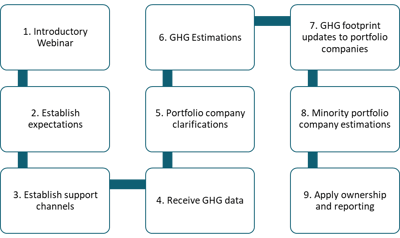4 things to consider when calculating GHG emissions across a portfolio
 Calculating the GHG or carbon emissions of an organisation is a key KPI for businesses to communicate their impact on the environment to stakeholders. Commonly grouped into scopes, reporting on GHG impacts in different categories provides transparency on where the impacts have occurred within a business’s operations.
Calculating the GHG or carbon emissions of an organisation is a key KPI for businesses to communicate their impact on the environment to stakeholders. Commonly grouped into scopes, reporting on GHG impacts in different categories provides transparency on where the impacts have occurred within a business’s operations.
Calculating GHG emissions from investments (Scope 3, Category 15) can be daunting for private capital investors. In this article, we focus on this challenging category and outline four key things to consider when launching a program to accurately calculate GHG emissions across your entire portfolio.
GHG emissions scopes – GHG Protocol
The GHG Protocol classifies a company's GHG emissions into three categories or 'scopes', to unify reporting and accounting of emissions worldwide.
- Scope 1 emissions: Covers all direct emissions from owned or controlled sources, such as energy consumption, fuels, vehicles, etc.
- Scope 2 emissions: Covers indirect emissions from the generation of purchased electricity, steam, heating or cooling energy consumed by the company.
- Scope 3 emissions: Covers all indirect emissions that occur in the value chain of the reporting company, meaning that the emissions are out of the company’s operational control, including both upstream and downstream emissions. As scope 3 emissions are the result of activities from assets not owned by the company, one company’s scope 3 emissions may originate from another company’s scope 1, Scope 2 or even scope 3 emissions. Scope 3 emissions are split between 15 categories including Category 15: Investments.
Scope 3 Category 15: Investments - methodologies
In order to calculate the emissions from Scope 3, Category 15 (Investments), there are two overarching methodologies:
Investment-specific method: This method involves collecting scope 1 and 2 emissions (and scope 3 when “significant”) from the investee company and allocating the emissions based upon the share of investment.
Average-data method: This method uses revenue data combined with “EEIO” (environmentally extended input-out) data to estimate the scope 1 and scope 2 emissions from the investee company and allocate emissions based upon a share of investment.
Many organisations will use the EEIO model as a first step. To do this, they will take the revenue of the investee company and multiply it by the appropriate EEIO emission factor that is representative of the investee company’s industry sector. They will then use its proportional share of equity to allocate the estimated scope 1 and scope 2 emissions of the investee company. However, EEIO has known limitations, notably:
- It is not possible to differentiate between investments within a particular sector outside of financial metrics.
- Year-on-year changes and improvements in a specific company’s operational GHG footprint are not captured.
- The data is based on averages, rather than accurate primary data.
Four things to consider when starting the investment-specific method of data collection
Tackling the investment-specific approach can seem daunting for an investor. Here, we outline four considerations when launching a program to tackle the investment-specific method of data collection for private investors:
- Define an engagement program, not a project

Firstly, it is essential to look at the investment-specific method of calculating GHG emissions as a program, rather than a project. This will embed a long-term approach to how data is collected, can be improved over time and create buy-in for environmental improvements and target setting.
Key steps in launching an investment-specific GHG data collection program across a portfolio:
- Communicate expectations and the journey to portfolio companies
As with any data request, it is essential to communicate what is required clearly but also expand on the when, how and why. Portfolio companies will look to investors for guidance on what is needed today but also understand what the journey will look like. For many privately held companies, they may not historically have been required to report on environmental or carbon data and as such, an educational element to communication is key.
Some examples of what to communicate when asking for GHG data:
- Scope definitions
- Types of GHG emissions data
- Underlying data requirement (e.g. units, type and amount of fuel)
- How to estimate if you’re asking them to do so
- Notes, assumptions and coverage information
- Whether a data source is required or desired
- How to submit the information (software / offline)
- Provide a tailored approach but consistent tools
Portfolio companies will be at different stages of their GHG journeys so it is important to tailor content for different audiences based on the maturity of their reporting. Complementing the data request with relevant resources such as educational webinars, user guides, training videos, hotlines and drop-in Q&A sessions will also underpin a program structure.
Understanding different levels of reporting maturity in portfolio companies
- For portfolio companies who have never calculated their footprint before and are just starting the process, providing simple, step-by-step and easy-to-use tools will ensure they are supported in the right way. With the use of the right tools and guidance, these companies can calculate their own GHG footprint accurately without having to engage with consultants on lengthy and costly projects.
- There will also be immature but ambitious portfolio companies, that want to calculate and report ESG and emissions data at a granular level and set targets. Providing this group of companies with the right enterprise-level tools to enable them to not just report, but also manage and mitigate GHG emissions will ensure that a management and mitigation agenda can be embedded from the outset.
- The mature reporter portfolio companies will most likely already be reporting their GHG emissions as part of their ESG reporting strategy. For this group, it’s important that you have the right mechanism in place to capture data from them in a way that eliminates duplication (but ensures consistency).
-
Document assumptions, estimations and approach
It is important to define a methodology for majority and minority portfolio companies and how a bottom-up approach to data collection might need to be tailored (or completed by EEIO) to complete the reporting picture.
A common question is when and how Scope 3 data should be included in an investment-specific calculation. For portfolio companies in certain sectors (e.g. manufacturing and retail) this could be a large task and a Scope 3 reporting journey for the portfolio company.
The GHG Protocol Scope 3 Standard states that it “does not set a threshold above which scope 3 emissions should be included; instead, reporting companies should develop their own significance threshold based on their business goals.”
EEIO data can be used to estimate the relative size of Scope 3 emissions compared to Scope 1 and Scope 2 emissions for sectors to help determine where investment-specific approaches are needed. This will ensure that portfolio company data requests are (a) targeted and (b) value-driven.
Other considerations such as ownership data, apportioning ownership data from investment and divestment dates and estimating minority portfolio company data are key to ensuring that a portfolio footprint is as comprehensive as possible.
Finally, in addition to common intensity metrics (e.g. full-time employees, revenue), a diverse portfolio may benefit from industry-specific groupings to sub-analyse some intensity level trends within a portfolio. For example, if you have several portfolio companies in the retail space, floor area could be a useful normalisation metric to compare and aggregate Scope 1 + 2 emissions by square foot as a KPI.
In conclusion, it is important to approach investment-specific GHG reporting (or bottom-up GHG reporting) as a program that will set portfolio companies as stewards for responsible ESG.
Greenstone and portfolio GHG emissions measurement
Greenstone has been providing sustainability and ESG software solutions, and enabling the calculation of accurate GHG data for its global client base, for 15 years.
Through its award-winning InvestorPortal solution - focused on the collection, management and analysis of ESG and carbon data across a portfolio – Greenstone is enabling global PE firms to measure the carbon impact of their portfolios.
Greenstone’s InvestorPortal is a purpose-built responsible investing solution that provides centralised analysis of ESG data at portfolio, fund and portfolio company level. As well as simplifying the collection, management and analysis of standard and proprietary ESG data and documents, InvestorPortal enables location-based GHG emissions calculation, customised scoring and ratings and portfolio engagement.
Greenstone’s Enterprise solution enables companies to collect, manage, analyse and report the data required to monitor and disclose sustainability and ESG performance with accuracy and confidence. The easy-to-use, secure platform has Environment, Frameworks and Health & Safety modules to provide users with a complete picture of their GHG emissions, ESG performance and progress against targets through better quality data.










